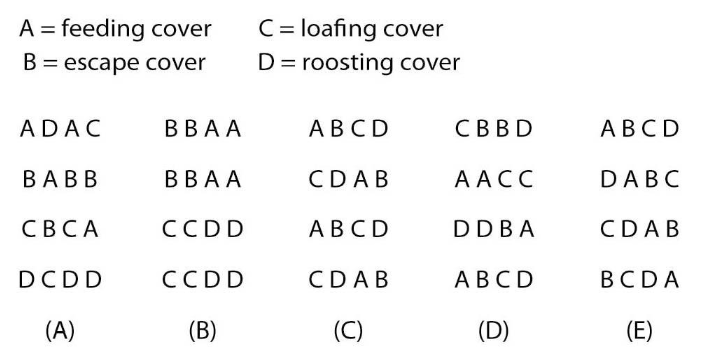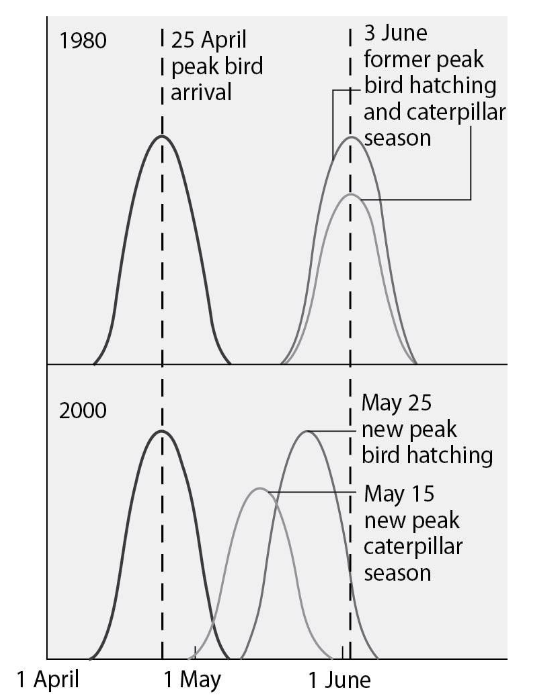Instructions for Side by Side Printing
- Print the notecards
- Fold each page in half along the solid vertical line
- Cut out the notecards by cutting along each horizontal dotted line
- Optional: Glue, tape or staple the ends of each notecard together
Biology in Focus Ch. 43
front 1 1) Which of the following ecological locations has the greatest
species diversity? | back 1 Answer: C |
front 2 2) Invasive species are introduced by humans to new geographic
locations and | back 2 Answer: C |
front 3 3) Estimates of current rates of extinction | back 3 Answer: C |
front 4 4) Extinction is a natural phenomenon. It is estimated that 99% of
all species that ever lived are now extinct. Why then do we say that
we are now experiencing an extinction (loss of biodiversity)
crisis? | back 4 Answer: C |
front 5 5) Which of the following provides the best evidence of a
biodiversity crisis? | back 5 Answer: D |
front 6 6) Although extinction is a natural process, current extinctions are
of concern to environmentalists because | back 6 Answer: C |
front 7 7) Which of the following terms includes all of the others? | back 7 Answer: B |
front 8 8) According to the U.S. Endangered Species Act (ESA), the difference
between an endangered species and a threatened one is that | back 8 Answer: A |
front 9 9) What term did E. O. Wilson coin for our innate appreciation of
wild environments and living organisms? | back 9 Answer: C |
front 10 10) We should care about loss in biodiversity in the populations of
other species because of | back 10 Answer: E |
front 11 11) The most serious consequence of a decrease in global biodiversity
would be the | back 11 Answer: B |
front 12 12) Which of the following is the most direct threat to
biodiversity? | back 12 Answer: D |
front 13 13) According to most conservation biologists, the single greatest
threat to global biodiversity is | back 13 Answer: D |
front 14 14) What is the biological significance of genetic diversity between
populations? | back 14 Answer: A |
front 15 15) Introduced species can have deleterious effects on biological
communities by | back 15 Answer: E |
front 16 16) Overexploitation encourages extinction and is most likely to
affect | back 16 Answer: B |
front 17 17) How might the extinction of some Pacific Island bats called
"flying foxes" threaten the survival of over 75% of the tree
species in those islands? | back 17 Answer: D |
front 18 18) Of the following ecosystem types, which have been impacted the
most by humans? | back 18 Answer: A |
front 19 19) The introduction of the brown tree snake in the 1940s to the
island of Guam has resulted in | back 19 Answer: B |
front 20 20) Which of the following examples poses the greatest potential
threat to biodiversity? | back 20 Answer: D |
front 21 21) Which of the following is a type of research in which a
conservation biologist would be involved? | back 21 Answer: E |
front 22 22) Which of the following species was driven to extinction by
overexploitation by hunters/fishermen? | back 22 Answer: B |
front 23 23) Which of the following conditions is the most likely indicator of
a population in an extinction vortex? | back 23 Answer: D |
front 24 24) Review the formula for effective population size. Imagine a
population of 1,000 small rodents. Of these, 300 are breeding females,
300 are breeding males, and 400 are nonbreeding juveniles. What is the
effective population size? | back 24 Answer: C |
front 25 25) If the sex ratio in a population is significantly different from
50:50, then which of the following will always be true? | back 25 Answer: E |
front 26 26) Which of the following life history traits can potentially
influence effective population size (Ne)? | back 26 Answer: E |
front 27 27) The word triage originated during World War I and was first used
by French doctors in prioritizing patients based on the severity of
their wounds, because there were more wounded soldiers in need of
urgent care than there were resources to treat them. Conservation
biologists have to make similar determinations with degraded
ecosystems. Which of the following is the most important consideration
when it comes to managing for maintenance of biodiversity? | back 27 Answer: B |
front 28 28) The primary difference between the small-population approach
(S-PA) and the declining-population approach (D-PA) to biodiversity
recovery is | back 28 Answer: A |
front 29 29) The long-term problem with red-cockaded woodpecker habitat
intervention in the southeastern United States is | back 29 Answer: D |
front 30 30) Managing southeastern forests specifically for the red-cockaded
woodpecker | back 30 Answer: B |
front 31 31) Which of the following is true about the current research
regarding forest fragmentation? | back 31 Answer: B |
front 32 32) According to the small-population approach, what would be the
best strategy for saving a population from extirpation? | back 32 Answer: C |
front 33 33) Relatively small geographic areas with high concentrations of
endemic species and a large number of endangered and threatened
species are known as | back 33 Answer: C |
front 34 34) How is habitat fragmentation related to biodiversity
loss? | back 34 Answer: C |
front 35 35) Brown-headed cowbirds utilize fragmented forests effectively
by | back 35 Answer: B |
front 36 36) Which of the following is consistent with forest fragmentation
research? | back 36 Answer: C |
front 37 37) How are movement corridors potentially harmful to certain
species? | back 37 Answer: C |
front 38 38) Biodiversity hot spots are not necessarily the best choice for
nature preserves because | back 38 Answer: C |
front 39 39) The success with which plants extend their range northward
following glacial retreat is best determined by | back 39 Answer: C |
front 40 40) As the climate changes because of global warming, species' ranges
of plants in the Northern Hemisphere may move northward, using
effective reproductive adaptations to disperse their seeds. The trees
that are most likely to avoid extinction in such an environment are
those that | back 40 Answer: A |
front 41 41) If global warming continues at its present rate, which biomes
will likely take the place of the coniferous forest (taiga)? | back 41 Answer: B |
front 42 42) Which of the following investigations would shed the most light
on the future distribution of organisms in temperate regions that are
faced with climate change? | back 42 Answer: B |
front 43 43) Burning fossil fuels releases oxides of sulfur and nitrogen.
These air pollutants can be responsible for | back 43 Answer: E |
front 44 44) What is the biggest problem with selecting a site for a
preserve? | back 44 Answer: B |
front 45 45) What is a critical load? | back 45 Answer: D |
front 46 46) The use of DDT as an insecticide in the United States has been
outlawed since 1971, yet is still a problem for certain top-level
carnivores in the United States. Which of the following choices best
explains this apparent incongruity? | back 46 Answer: A |
front 47 47) Agricultural lands frequently require nutrient augmentation
because | back 47 Answer: B |
front 48 48) Which of the following refers to the reflecting and absorption of
infrared radiation by atmospheric methane, carbon dioxide, and
water? | back 48 Answer: D |
front 49 49) What is caused by excessive nutrient runoff into aquatic
ecosystems? | back 49 Answer: E |
front 50 50) What causes extremely high levels of toxic chemicals in
fish-eating birds? | back 50 Answer: C |
front 51 51) The biggest challenge that Costa Rica will likely face in its
dedication to conservation and restoration in the future is | back 51 Answer: A |
front 52 52) Which of the following nations has become a world leader in the
establishment of zoned reserves? | back 52 Answer: A |
front 53 53) Which of the following is most key to understanding the
demographic transition in human population growth? | back 53 Answer: C |
front 54 54) Which statement is true with regard to human population
growth? | back 54 Answer: C |
front 55 55) The main goal of sustainable development is to | back 55 Answer: C |
front 56 56) Which of the following best illustrates human efforts to improve
environmental sustainability? | back 56 Answer: B |
front 57 57) Which of the following best illustrates the sustainable use of a
resource? | back 57 Answer: C |
front 58 58) The concept of sustainable development emphasizes | back 58 Answer: A |
front 59 59) Which one of the following is the most sustainable source of
energy? | back 59 Answer: C |
front 60  1) Study the information in Figure 43.1 about quail habitats.
Assuming that only one quail can occupy a habitat where all cover
requirements are met, what is the maximum number of quail that could
inhabit any of the hypothetical plots shown? | back 60 Answer: E |
front 61  Flycatcher birds that migrate from Africa to Europe feed their nestlings a diet that is almost exclusively moth caterpillars. The graph in Figure 43.2 shows the mean dates of arrival, bird hatching, and peak caterpillar season for the years 1980 and 2000. 2) The shift in the peak of caterpillar season is most likely due
to | back 61 Answer: D |
front 62  Flycatcher birds that migrate from Africa to Europe feed their
nestlings a diet that is almost exclusively moth caterpillars. The
graph in Figure 43.2 shows the mean dates of arrival, bird hatching,
and peak caterpillar season for the years 1980 and 2000. | back 62 Answer: C |
front 63 1) Suppose you attend a town meeting at which some experts tell the
audience that they have performed a cost-benefit analysis of a
proposed transit system that would probably reduce overall air
pollution and fossil fuel consumption. The analysis, however, reveals
that ticket prices will not cover the cost of operating the system
when fuel, wages, and equipment are taken into account. As a
biologist, you know that if ecosystem services had been included in
the analysis the experts might have arrived at a different answer. Why
are ecosystem services rarely included in economic analyses? | back 63 Answer: A |
front 64 2) Your friend is wary of environmentalists' claims that global
warming could lead to major biological change on Earth. Which of the
following statements can you use in response to your friend's
suspicions? | back 64 Answer: E |
front 65 1) One characteristic that distinguishes a population in an
extinction vortex from most other populations is that | back 65 Answer: D |
front 66 2) The main cause of the increase in the amount of CO2 in Earth’s
atmosphere over the past 150 years is | back 66 Answer: D |
front 67 3) What is the single greatest threat to biodiversity? | back 67 Answer: E |
front 68 4) Which of the following is a consequence of biological
magnification? | back 68 Answer: A |
front 69 5) Which of the following strategies would most rapidly increase the
genetic diversity of a population in an extinction vortex? | back 69 Answer: C |
front 70 6) Of the following statements about protected areas that have been
established to preserve biodiversity, which one is not
correct? | back 70 Answer: A |